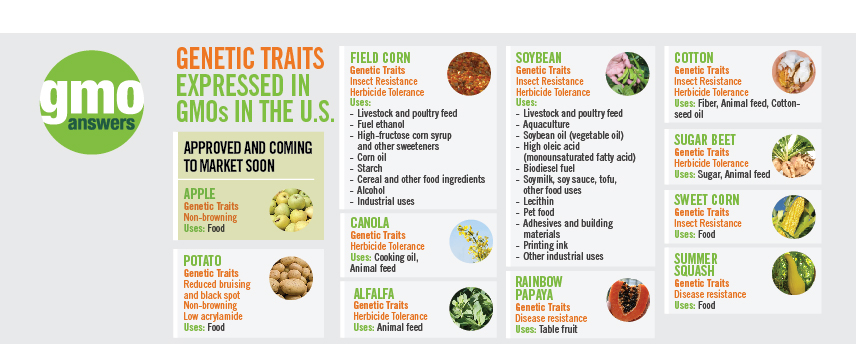Question
What is the purpose genetic engineering of crop plants and domestic animals?
Submitted by: ladyt8215
Answer
Expert response from Community Manager
Moderator for GMOAnswers.com
Tuesday, 26/01/2016 15:27
Crops are genetically modified to achieve a desired trait, such as resistance to an insect or disease. More detail on some of the traits crops are genetically modified to achieve and how they are beneficial to farming is included below:
- Insect resistance. This trait provides farmers with season-long protection against target pests, reduces the need for pesticide applications, and lowers input costs.
- Drought resistance. GM crops that express drought resistance can grow in much drier areas, conserving water and other environmental resources.
- Herbicide tolerance. Crops that can tolerate specific herbicides allow farmers to fight weeds by applying herbicides only when needed and enable them to use no-till production methods that preserve topsoil, prevent erosion, and reduce carbon emissions.
- Disease resistance. Through genetic modification, the Hawaiian papaya industry was able to recover from the devastating papaya ringspot virus that had crippled the industry. We created a video to explain this in more detail here: https://www.youtube.com/watch?v=2G-yUuiqIZ0

The GM salmon was recently approved by the FDA and is the first GMO animal to be approved. The salmon was genetically modified for a few reasons. Since Salmon is one of the more popular fishes available and also the second most consumed seafood in the US there has been a decline in population. By genetic engineering the Salmon, this will help it grow faster.
Another reason this GMO Salmon was developed was to help benefit the environment, in multiple ways such as:
- Conserve wild fish populations. The AquAdvantage® salmon grows to market-size using 25 percent less feed than any Atlantic salmon on the market today. This means that it requires less wild fish to be converted into salmon feed – which conserves wild fish stocks. Using GE ingredients to replace fishmeal and fish oil requirements in fish feeds are helping aquaculture to be even more sustainable. (Click here to learn more.)
- Reduce carbon emissions. Because the AquaBounty salmon is farmed in land-based facilities that are close to cities, it only needs to travel a short distance to the grocery store. This cuts down on transportation and, therefore, carbon emissions, from farm to table. Transporting the AquaBounty salmon emits 23 to 25 times less CO2 than the two major sources of US Atlantic salmon.
- Provide low impact fish farming. AquaBounty has full control over their aquaculture rearing ecosystem. This means they have total control over water input and discharge, sanitation and the ability to recycle resources. Learn more about the process on AquaBounty’s website.”
Read more about this first GMO animal, why and how it was created here: https://gmoanswers.com/nine-9-things-you-need-know-about-gmo-salmon
We hope the information provided answers your question. If you have any further questions, please ask. Also, feel free to contribute to the discussion in the comment section below!
Answer
Expert response from Community Manager
Moderator for GMOAnswers.com
Tuesday, 26/01/2016 15:27
Crops are genetically modified to achieve a desired trait, such as resistance to an insect or disease. More detail on some of the traits crops are genetically modified to achieve and how they are beneficial to farming is included below:
- Insect resistance. This trait provides farmers with season-long protection against target pests, reduces the need for pesticide applications, and lowers input costs.
- Drought resistance. GM crops that express drought resistance can grow in much drier areas, conserving water and other environmental resources.
- Herbicide tolerance. Crops that can tolerate specific herbicides allow farmers to fight weeds by applying herbicides only when needed and enable them to use no-till production methods that preserve topsoil, prevent erosion, and reduce carbon emissions.
- Disease resistance. Through genetic modification, the Hawaiian papaya industry was able to recover from the devastating papaya ringspot virus that had crippled the industry. We created a video to explain this in more detail here: https://www.youtube.com/watch?v=2G-yUuiqIZ0

The GM salmon was recently approved by the FDA and is the first GMO animal to be approved. The salmon was genetically modified for a few reasons. Since Salmon is one of the more popular fishes available and also the second most consumed seafood in the US there has been a decline in population. By genetic engineering the Salmon, this will help it grow faster.
Another reason this GMO Salmon was developed was to help benefit the environment, in multiple ways such as:
- Conserve wild fish populations. The AquAdvantage® salmon grows to market-size using 25 percent less feed than any Atlantic salmon on the market today. This means that it requires less wild fish to be converted into salmon feed – which conserves wild fish stocks. Using GE ingredients to replace fishmeal and fish oil requirements in fish feeds are helping aquaculture to be even more sustainable. (Click here to learn more.)
- Reduce carbon emissions. Because the AquaBounty salmon is farmed in land-based facilities that are close to cities, it only needs to travel a short distance to the grocery store. This cuts down on transportation and, therefore, carbon emissions, from farm to table. Transporting the AquaBounty salmon emits 23 to 25 times less CO2 than the two major sources of US Atlantic salmon.
- Provide low impact fish farming. AquaBounty has full control over their aquaculture rearing ecosystem. This means they have total control over water input and discharge, sanitation and the ability to recycle resources. Learn more about the process on AquaBounty’s website.”
Read more about this first GMO animal, why and how it was created here: https://gmoanswers.com/studies/9-things-you-need-know-about-gmo-salmon
We hope the information provided answers your question. If you have any further questions, please ask. Also, feel free to contribute to the discussion in the comment section below!
Video: About GMO Answers